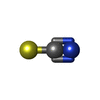+ データを開く
データを開く
- 基本情報
基本情報
| 登録情報 | データベース: PDB / ID: 8wxi | ||||||
|---|---|---|---|---|---|---|---|
| タイトル | human CLC-1 D136G delayed rectification | ||||||
 要素 要素 | Chloride channel protein 1 | ||||||
 キーワード キーワード | MEMBRANE PROTEIN / Channel | ||||||
| 機能・相同性 |  機能・相同性情報 機能・相同性情報voltage-gated chloride channel activity / neuronal action potential propagation / chloride transport / chloride channel complex / T-tubule / muscle contraction / chloride transmembrane transport / Stimuli-sensing channels / protein homodimerization activity / plasma membrane 類似検索 - 分子機能 | ||||||
| 生物種 |  Homo sapiens (ヒト) Homo sapiens (ヒト) | ||||||
| 手法 | 電子顕微鏡法 / 単粒子再構成法 / クライオ電子顕微鏡法 / 解像度: 2.57 Å | ||||||
 データ登録者 データ登録者 | Zhang, M.F. | ||||||
| 資金援助 | 1件
| ||||||
 引用 引用 |  ジャーナル: To Be Published ジャーナル: To Be Publishedタイトル: CLC-1 in SCN environment 著者: Zhang, M.F. | ||||||
| 履歴 |
|
- 構造の表示
構造の表示
| 構造ビューア | 分子:  Molmil Molmil Jmol/JSmol Jmol/JSmol |
|---|
- ダウンロードとリンク
ダウンロードとリンク
- ダウンロード
ダウンロード
| PDBx/mmCIF形式 |  8wxi.cif.gz 8wxi.cif.gz | 183.4 KB | 表示 |  PDBx/mmCIF形式 PDBx/mmCIF形式 |
|---|---|---|---|---|
| PDB形式 |  pdb8wxi.ent.gz pdb8wxi.ent.gz | 136.9 KB | 表示 |  PDB形式 PDB形式 |
| PDBx/mmJSON形式 |  8wxi.json.gz 8wxi.json.gz | ツリー表示 |  PDBx/mmJSON形式 PDBx/mmJSON形式 | |
| その他 |  その他のダウンロード その他のダウンロード |
-検証レポート
| 文書・要旨 |  8wxi_validation.pdf.gz 8wxi_validation.pdf.gz | 1.6 MB | 表示 |  wwPDB検証レポート wwPDB検証レポート |
|---|---|---|---|---|
| 文書・詳細版 |  8wxi_full_validation.pdf.gz 8wxi_full_validation.pdf.gz | 1.6 MB | 表示 | |
| XML形式データ |  8wxi_validation.xml.gz 8wxi_validation.xml.gz | 49.5 KB | 表示 | |
| CIF形式データ |  8wxi_validation.cif.gz 8wxi_validation.cif.gz | 67.4 KB | 表示 | |
| アーカイブディレクトリ |  https://data.pdbj.org/pub/pdb/validation_reports/wx/8wxi https://data.pdbj.org/pub/pdb/validation_reports/wx/8wxi ftp://data.pdbj.org/pub/pdb/validation_reports/wx/8wxi ftp://data.pdbj.org/pub/pdb/validation_reports/wx/8wxi | HTTPS FTP |
-関連構造データ
| 関連構造データ |  37908MC  8wxjC M: このデータのモデリングに利用したマップデータ C: 同じ文献を引用 ( |
|---|---|
| 類似構造データ | 類似検索 - 機能・相同性  F&H 検索 F&H 検索 |
- リンク
リンク
- 集合体
集合体
| 登録構造単位 | 
|
|---|---|
| 1 |
|
- 要素
要素
| #1: タンパク質 | 分子量: 108675.133 Da / 分子数: 2 / 変異: D136G / 由来タイプ: 組換発現 / 由来: (組換発現)  Homo sapiens (ヒト) / 遺伝子: CLCN1 / 発現宿主: Homo sapiens (ヒト) / 遺伝子: CLCN1 / 発現宿主:  Homo sapiens (ヒト) / 参照: UniProt: P35523 Homo sapiens (ヒト) / 参照: UniProt: P35523#2: 化合物 | ChemComp-SCN / 研究の焦点であるリガンドがあるか | Y | Has protein modification | N | |
|---|
-実験情報
-実験
| 実験 | 手法: 電子顕微鏡法 |
|---|---|
| EM実験 | 試料の集合状態: PARTICLE / 3次元再構成法: 単粒子再構成法 |
- 試料調製
試料調製
| 構成要素 | 名称: CLC-1 channel / タイプ: COMPLEX / Entity ID: #1 / 由来: RECOMBINANT |
|---|---|
| 由来(天然) | 生物種:  Homo sapiens (ヒト) Homo sapiens (ヒト) |
| 由来(組換発現) | 生物種:  Homo sapiens (ヒト) Homo sapiens (ヒト) |
| 緩衝液 | pH: 7.4 |
| 試料 | 包埋: NO / シャドウイング: NO / 染色: NO / 凍結: YES |
| 急速凍結 | 凍結剤: ETHANE |
- 電子顕微鏡撮影
電子顕微鏡撮影
| 実験機器 |  モデル: Titan Krios / 画像提供: FEI Company |
|---|---|
| 顕微鏡 | モデル: FEI TITAN KRIOS |
| 電子銃 | 電子線源:  FIELD EMISSION GUN / 加速電圧: 300 kV / 照射モード: SPOT SCAN FIELD EMISSION GUN / 加速電圧: 300 kV / 照射モード: SPOT SCAN |
| 電子レンズ | モード: BRIGHT FIELD / 最大 デフォーカス(公称値): 1800 nm / 最小 デフォーカス(公称値): 1200 nm |
| 撮影 | 電子線照射量: 40 e/Å2 フィルム・検出器のモデル: FEI FALCON IV (4k x 4k) |
- 解析
解析
| CTF補正 | タイプ: NONE |
|---|---|
| 3次元再構成 | 解像度: 2.57 Å / 解像度の算出法: FSC 0.143 CUT-OFF / 粒子像の数: 38321 / 対称性のタイプ: POINT |
 ムービー
ムービー コントローラー
コントローラー




 PDBj
PDBj



